Say “Itadakimasu!” With These Delicious Dishes!

CONTENTS
Top Photo: takedahrs on Pixabay
Previously used photo: “Hiroshima-Style Okonomiyaki” by Ajay Suresh from New York, NY, USA, licensed under the Creative Commons Attribution 2.0 Generic license (cc-by-2.0). No changes or alterations were made. Wikimedia Commons Link
“Itadakimasu” (いただきます) is often translated into English as “I humbly receive”. When used in a mealtime setting, it has been likened to saying “Bon appétit”, “thank you for this food”, or simply “let’s eat”. Some have even likened it to saying grace. Whatever the case, it’s definitely a word you want to add to your Japanese vocabulary.
Now that you know how to start off a meal, let’s talk about some foods in Japan.
I really love Japanese food! That’s why I want to share it with all of you.
I’ve been living in Japan for many years, and trying different foods is one of my favorite things, especially when I visit other prefectures.
There are many regional specialties and signature dishes across Japan, and some cities or areas have their own spin on one particular dish. There are also foods adapted from other countries and given a uniquely Japanese twist. The choices seem almost limitless at times, and just deciding what to eat next can keep any foodie busy for hours.
Here’s just a small sampling of the many dishes you can find across Japan. Some are full-fledged lunches or dinners, while others are smaller foods to snack on alongside a cold drink, or desserts to top off another meal. These are ten of my favorites, but there are of course many more!
Proper Meals
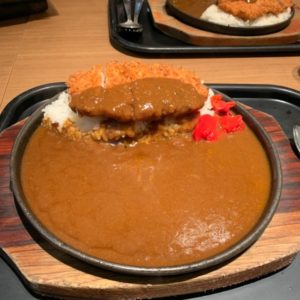 Japanese Curry (カレーライス)
Japanese Curry (カレーライス)
“Kare-raisu” is how to pronounce Japanese curry. White rice is served along with a curry sauce containing ingredients such as onions, carrots, and potatoes.
Beef, pork, and chicken are popular choices if the curry contains meat. The levels of spiciness vary. While one can find traditionally zesty curry too, milder, sweeter tastes like Kanazawa curry are also popular throughout the country.
In addition to the curry sauce itself, toppings such a pork or chick katsu (fried cutlet), fried oysters and grilled vegetables are popular. You can also find curry-flavored udon (カレーうどん), curry ramen (カレーラーメン), and curry bread (カレーパン).
 Okonomiyaki (お好み焼き)
Okonomiyaki (お好み焼き)
Okonomiyaki is a popular pan-fried dish. It’s essentially a pancake that consists of batter and cabbage. From there, the other ingredients are up to you! The meaning of okonomi literally means “to one’s liking.” Veggies, pork, squid, etc. are often popular choices to pile on. Or in, as I’ll explain.
The dish is said to have originated in Osaka, but is also a trademark of the Hiroshima area. The style of making okonomiyaki in the two cities has diverged somewhat over time.
Hiroshima-style uses far more cabbage, and the ingredients are layered during the cooking stage. It also often includes a layer of yakisoba (fried noodles) and is sometimes topped with an egg. This style requires more skill in preparing (so as to not make a big mess) and it’s more common to have it prepared and then served to you.
Osaka-style on the other hand uses more batter and mixes the ingredients together before cooking. This results in a cleaner pancake style, and Osaka-style okonomiyaki restaurants let patrons cook it themselves on tabletop grills with large metal spatulas that can be used to cut and serve it pizza-style. Both versions are are well worth trying!
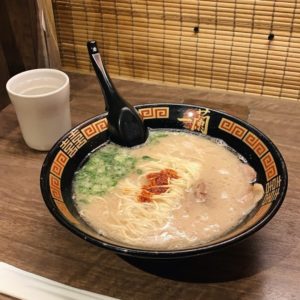 Ramen (ラーメン)
Ramen (ラーメン)
I think everyone is familiar with Japan’s take on Chinese wheat noodles. But far from the instant kind popular around the world, freshly-made restaurant ramen has a great deal more going on with it.
The primary broth flavors are shio (salt), shoyu (soy sauce), tonkotsu (pork bone), and miso ramen, but even these have been combined over the years in experimental new ways.
My personal favorite is tonkotsu ramen, a speciality of Hakata. Once you have the broth, you have different types of noodles (ranging in softness) and then you add many different toppings like boiled eggs, spring onions, menma (Japanese Lacto-fermented bamboo shoots), and braised pork. There are an endless array of varieties and local styles, some of which we have covered in the past here on MUSUBI!
A common food in wintertime as well as a popular post-drinking party meal, ramen served piping hot in a big bowl at a restaurant is a must-try!
Small Bites and Snacks
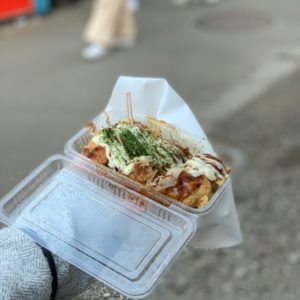 Takoyaki (たこ焼き)
Takoyaki (たこ焼き)
Takoyaki, or “octopus balls”, is one of Japan’s best-known street foods from Osaka. These ball-shaped dumplings are also fun and easy to make with your friends and family at home! If you have a takoyaki grill, they make the perfect food for a house party.
If you’ve never tried octopus before, don’t be deterred- it is delicious, especially when served with such flavors as takoyaki sauce (similar to Worcestershire sauce) and sweet Japanese-style mayonnaise. If you’re just not up to it, it’s also possible to make takoyaki with other ingredients (everything from Nutella to strawberries) but the traditional octopus style is highly recommended to truly put the tako in takoyaki.
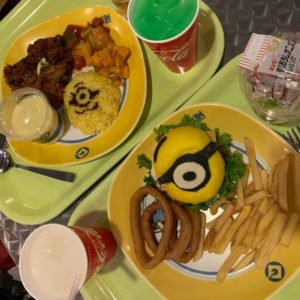 Amusement Park Food (遊園地のフード)
Amusement Park Food (遊園地のフード)
Here’s one you may not have expected. Japan is well-known for its “kawaii culture” of cute things. This extends all the way to foods found at amusement and theme parks, which you can get in addition to more conventional fare.
Left: Foods from Universal Studio Japan, the Minion Burger Set and Minion Fried Chicken and Sautéed Veggie Platter Set.
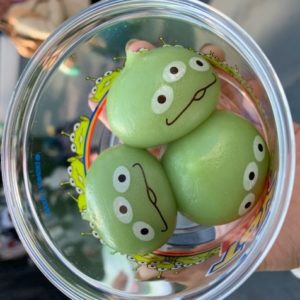 Right: from Tokyo Disney Land, it’s the Little Green Men Mochi with chocolate, strawberry, and custard filling.
Right: from Tokyo Disney Land, it’s the Little Green Men Mochi with chocolate, strawberry, and custard filling.
And that’s just a small sampling of what you can find. Any theme park or zoo worth its salt will have stalls, restaurants or a food court, and there are many delicious treasures to be found within. There are even food-themed attractions and museums, such as the Takoyaki Museum in Osaka!
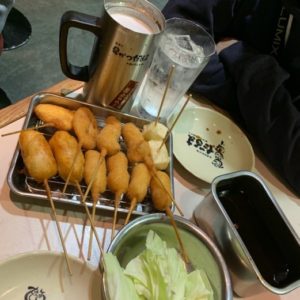 Kushikatsu/Kushiage (串カツ・串揚げ)
Kushikatsu/Kushiage (串カツ・串揚げ)
Kushikatsu, also known as kushiage, are deep-fried skewered meat and vegetables. Kushi (串) means “skewer” and age (揚げ) means “fry”. Katsu as we’ve establish is a fried, breaded cutlet similar to a pork chop.
Kushikatsu generally uses chicken, pork, seafood, seasonal vegetables, and even quail eggs. It’s a popular in staple in many izakaya (similar to a pub).
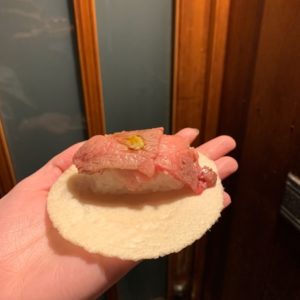 Wagyu Beef Sushi (和牛牛寿司)
Wagyu Beef Sushi (和牛牛寿司)
Sushi is healthy Japanese specialty that has taken the world by storm in recent years. While most outside Japan associate sushi with strictly seafood or vegetables, there are actually many kinds of things that can be used as sushi toppings. Corn, katsu slices, grilled or raw pork and wagyu (Japanese beef)… the list goes on!
Wagyu Beef Sushi is expensive due to the high quality of the meat, but well worth trying at least once in your life if you like beef.
Sweets & Desserts
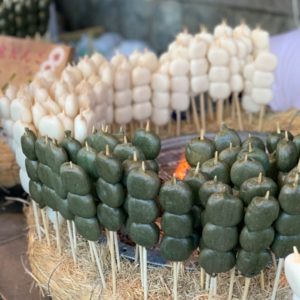 Dango (団子)
Dango (団子)
Dango is a Japanese sweet rice ball dumpling made from mochiko (sticky rice flower). It is made using a similar method as mochi (rice cake). It is often served with matcha or green tea.
Dango are eaten year-round, but the different varieties are traditionally eaten in specific seasons. Three to four dango are often served on a skewer. Dango shops are often found near shrines and temples.
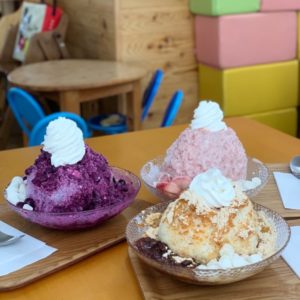 Kakigōri (かき氷)
Kakigōri (かき氷)
Kakigōri is also known as Japanese shaved ice. A summertime favorite, it can be given a wide range of flavors due to different kinds of of syrup.
Some modern styles of kakigōri are even served with your choices of topping, including whipped cream, ice cream, azuki (red beans), mochi, condensed milk, or sliced fruits.
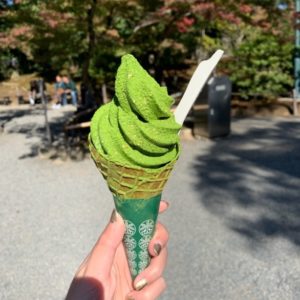
Matcha Soft Cream (抹茶ソフトクリーム)
What comes to your mind when you think of ice cream flavors in Japan? Probably matcha or green tea! You can find matcha soft cream everywhere in Japan, but I recommend trying it in Kyoto, due to the area’s famed matcha.
Next time you take a trip to the ancient capital, be sure to snack on (finish off a meal with) this tasty treat!
There’s a lot more to Japanese food that what we’ve covered here. I’m sure you would love trying some or all of these! Whether you’re in Japan now or hoping to come here some day, it can’t hurt to make yourself a mental (or physical) checklist of the Japanese foods you’d like to try!
And remember, when finished with a meal in Japan, always say gochisōsama-deshita (ごちそうさまでした) or “thanks for the meal”! And thanks for reading!
Photo Credits:
Top Photo: takedahrs on Pixabay
Previously used photo: “Hiroshima-Style Okonomiyaki” by Ajay Suresh from New York, NY, USA, licensed under the Creative Commons Attribution 2.0 Generic license (cc-by-2.0). No changes or alterations were made. Wikimedia Commons Link
Additional photos provided by Sayaka Kondo
All other content (text) created by the original author and © 2020 MUSUBI by Borderlink
RELATED
-
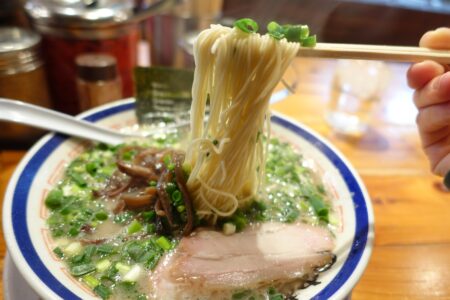
Ramen Jiro: Noodles of the Gods
Top Image: にゃん春さん on PhotoAC Are you a fan of food? Who isn’t, right? Let me put it another way: Do you enjoy … -
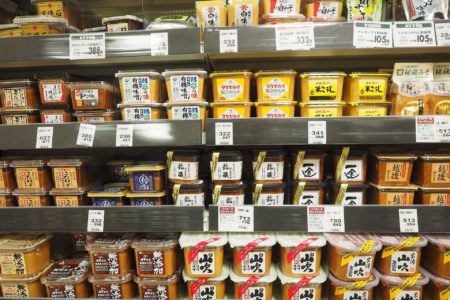
My Mighty Miso Adventure
Top Image: othree via Wikipedia, licensed under CC By 2.0 Miso (味噌) is fermented soybean paste that at first g… -

Good Eats: The Onion Burgers of Awaji
Top Image: yhp511 on Pixabay Works of antiquity such as the Kojiki and Nihonshoki describe Awaji Island as the…
PEOPLE

Sayaka Kondo
Has lived in Japan for many years
And calls it home!


